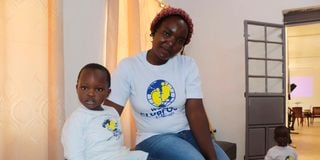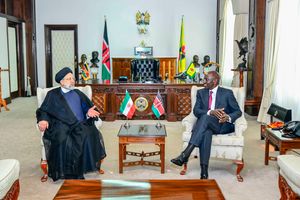Hospital giving children with foot deformity a chance to walk

Brenda Nyakiti and her child at Kendu Adventist Mission Hospital in Rachuonyo North. The child is undergoing clubfoot correction at the hospital.
What you need to know:
- Clubfoot may be caused by split spine, a birth defect in which a spinal cord fails to develop properly. Experts say clubfoot may also be due to hydrocephalus, a buildup of fluid in the cavities deep inside the brain.
- Clubfoot may also be secondary, occurring when there is another disease or condition.
- One in every 1,000 children born in Kenya has the condition and half of them are not fixed.
A child is considered a blessing, but one born with a deformity is seen as a curse in some communities.
Some parents sideline or hide children born with deformity. In worst cases, they are killed to prevent the “curse” from spreading within a family.
Unfounded myths about deformity, including being considered a punishment from God, are still passed down, yet modern medical care can address some of the challenges.
Take clubfoot for example. It is a birth defect in which the foot is twisted out of shape. The Health ministry identified clubfoot as one of the most common congenital conditions.
Some communities believe women who give birth to children with clubfood had extra-marital affairs while pregnant. Such myths humiliate couples. Others say the condition is caused when a foetus struggles to develop within a small womb.
Ms Brenda Nyakiti nearly yielded to the myths when she gave birth to a child with clubfeet two years ago. It was her first time witnessing the condition. “My child’s feet did not look okay, but the nurses told me they were fine,” she says.
She was advised to monitor the feet for one week at home and return to the hospital if there was no change. At home in Ndhiwa, Homa Bay County, some neighbours told her the condition was a side effect of family planning contraceptives.
“A lot of stories were told. It was my first time listening to such stories, some meant to demean me.”
Other parents have equally suffered humiliation. Mr Wayne Mboya, a father of two, says his second-born was diagnosed with clubfoot two months after birth. At first, his wife thought the foot would straighten up, so the couple did not bother to enquire about the condition.
“A nurse detected the problem when my wife took the child for postnatal care. We opted to repair the foot before it became worse.”
Upon getting advice that Kendu Adventist Mission Hospital has specialists who repair the condition for free, both Ms Nyakiti and Mr Mboya took their children there. In South Nyanza, it is the only hospital offering the service and it has helped more than 60 children since the programme began three years ago. The hospital has five therapists and three clinical officers, all trained by the Clubfoot Care for Kenya.
According to Dr Justin Kim, a physiotherapist and head of rehabilitation, the exact cause of clubfoot is unknown. It is, however, deemed hereditary.
Clubfoot may also be caused by split spine, a birth defect in which a spinal cord fails to develop properly. Experts say clubfoot may also be due to hydrocephalus, a buildup of fluid in the cavities deep inside the brain.
“Clubfoot may also be secondary, occurring when there is another disease or condition,” Dr Kim says, adding that one in every 1,000 children born in Kenya has the condition and half of them are not fixed.
Clubfoot can lead to death or severe disability if not repaired, Dr Kim says, explaining that it interferes with physical activities like running and jumping, rendering the foot soft and prone to infection if wounded.
“If the wound is not attended to fast, it can lead to amputation. In the worst scenario, death can occur if it is infected with bacteria.”
Meanwhile, children whose conditions are not fixed may need assistive devices like crutches to walk.
The mission hospital admits children aged two years and below. Mr Deryle Mbewa, an occupational therapist, says healing time depends on a patient’s age. A younger child heals faster.
Dr Kim says the earlier the condition is detected, the easier it is to repair. “We would need additional expertise if a child is older than two years. The procedure requires other specialised care when a child is older.”





